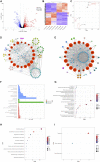Effects of NaCl Concentrations on Growth Patterns, Phenotypes Associated With Virulence, and Energy Metabolism in Escherichia coli BW25113
- PMID: 34484145
- PMCID: PMC8415458
- DOI: 10.3389/fmicb.2021.705326
Effects of NaCl Concentrations on Growth Patterns, Phenotypes Associated With Virulence, and Energy Metabolism in Escherichia coli BW25113
Abstract
According to the sit-and-wait hypothesis, long-term environmental survival is positively correlated with increased bacterial pathogenicity because high durability reduces the dependence of transmission on host mobility. Many indirectly transmitted bacterial pathogens, such as Mycobacterium tuberculosis and Burkhoderia pseudomallei, have high durability in the external environment and are highly virulent. It is possible that abiotic stresses may activate certain pathways or the expressions of certain genes, which might contribute to bacterial durability and virulence, synergistically. Therefore, exploring how bacterial phenotypes change in response to environmental stresses is important for understanding their potentials in host infections. In this study, we investigated the effects of different concentrations of salt (sodium chloride, NaCl), on survival ability, phenotypes associated with virulence, and energy metabolism of the lab strain Escherichia coli BW25113. In particular, we investigated how NaCl concentrations influenced growth patterns, biofilm formation, oxidative stress resistance, and motile ability. In terms of energy metabolism that is central to bacterial survival, glucose consumption, glycogen accumulation, and trehalose content were measured in order to understand their roles in dealing with the fluctuation of osmolarity. According to the results, trehalose is preferred than glycogen at high NaCl concentration. In order to dissect the molecular mechanisms of NaCl effects on trehalose metabolism, we further checked how the impairment of trehalose synthesis pathway (otsBA operon) via single-gene mutants influenced E. coli durability and virulence under salt stress. After that, we compared the transcriptomes of E. coli cultured at different NaCl concentrations, through which differentially expressed genes (DEGs) and differential pathways with statistical significance were identified, which provided molecular insights into E. coli responses to NaCl concentrations. In sum, this study explored the in vitro effects of NaCl concentrations on E. coli from a variety of aspects and aimed to facilitate our understanding of bacterial physiological changes under salt stress, which might help clarify the linkages between bacterial durability and virulence outside hosts under environmental stresses.
Keywords: Escherichia coli; bacterial survival; biofilm formation; glycogen; transcriptome; trehalose.
Copyright © 2021 Li, Xiong, Yang, Wang, Wang, Tang, Liu, Wang and Gu.
Conflict of interest statement
The authors declare that the research was conducted in the absence of any commercial or financial relationships that could be construed as a potential conflict of interest.
Figures







References
-
- Abdulkarim S., Fatimah A. B., Anderson J. G. (2009). Effect of salt concentrations on the growth of heat-stressed and unstressed escherichia coli. J. Food Agric. Environ. 7:4.
-
- Berlingerio M., Coscia M., Giannotti F., Monreale A., Pedreschi D. (2011). The pursuit of hubbiness: Analysis of hubs in large multidimensional networks. J. Comput. Sci. 2 223–237. 10.1016/j.jocs.2011.05.009 - DOI
LinkOut - more resources
Full Text Sources
Other Literature Sources
Miscellaneous

